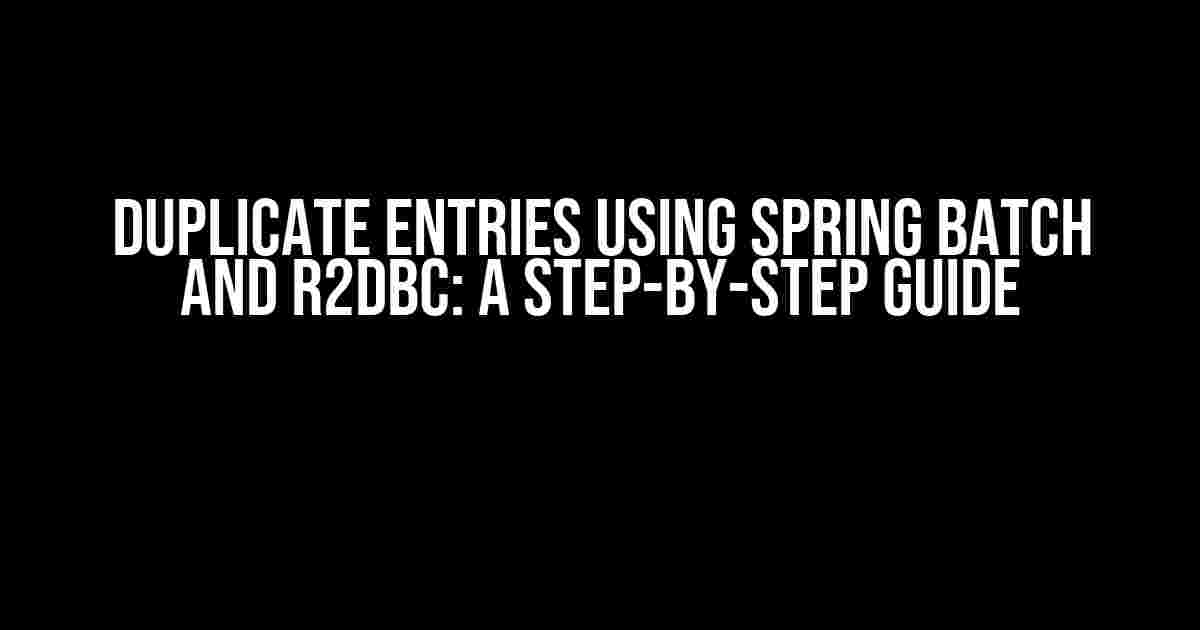Are you tired of dealing with duplicate entries in your database? Do you find yourself struggling to remove duplicates using traditional methods? Fear not, dear developer! With Spring Batch and R2DBC, you can easily identify and eliminate duplicate entries in your database. In this comprehensive guide, we’ll walk you through the process of using these powerful tools to simplify your data management tasks.
What are Duplicate Entries?
Duplicate entries, also known as duplicate records, refer to identical or nearly identical data points that appear multiple times in a database. These duplicates can occur due to various reasons, such as:
- Human error during data entry
- Data import or export issues
- System failures or crashes
- Data migration or integration problems
Duplicate entries can lead to data inconsistencies, errors, and even security breaches. It’s essential to remove these duplicates to ensure data integrity and maintain a clean database.
Why Use Spring Batch and R2DBC?
Spring Batch and R2DBC are two powerful tools that can help you tackle the problem of duplicate entries. Here’s why:
- Spring Batch: This framework is designed for batch processing and provides a robust and scalable solution for handling large datasets. It offers features like chunk-based processing, transaction management, and fault-tolerant processing.
- R2DBC: This is a reactive relational database connectivity driver that allows you to interact with relational databases in a non-blocking, reactive manner. It’s designed to work with Spring Batch and provides a more efficient and scalable alternative to traditional JDBC drivers.
By combining Spring Batch and R2DBC, you can create a robust and efficient solution for removing duplicate entries from your database.
Setting Up the Environment
Before we dive into the code, let’s set up the environment. You’ll need:
- Java 11 or later
- Spring Boot 2.3.0 or later
- R2DBC 0.8.0 or later
- A relational database (e.g., PostgreSQL, MySQL, or Oracle)
- Maven or Gradle for building and managing dependencies
Create a new Spring Boot project using your preferred IDE or by using the Spring Initializr tool. Add the following dependencies to your `pom.xml` file (if using Maven) or `build.gradle` file (if using Gradle):
<dependencies>
<dependency>
<groupId>org.springframework.boot</groupId>
<artifactId>spring-boot-starter-batch</artifactId>
</dependency>
<dependency>
<groupId>org.springframework.boot</groupId>
<artifactId>spring-boot-starter-data-jdbc</artifactId>
</dependency>
<dependency>
<groupId>org.springframework.boot</groupId>
<artifactId>spring-boot-starter-webflux</artifactId>
</dependency>
<dependency>
<groupId>io.r2dbc</groupId>
<artifactId>r2dbc-postgresql</artifactId>
</dependency>
</dependencies>
Replace `r2dbc-postgresql` with the R2DBC driver for your chosen database.
Configuring the Database
Create a new database or use an existing one. Create a table with a unique identifier (e.g., `id`) and at least one column that can contain duplicate values (e.g., `name`). For this example, we’ll use the following table structure:
CREATE TABLE users ( id SERIAL PRIMARY KEY, name VARCHAR(255) NOT NULL );
Insert some sample data into the table, including duplicates:
INSERT INTO users (name) VALUES ('John Doe');
INSERT INTO users (name) VALUES ('Jane Doe');
INSERT INTO users (name) VALUES ('John Doe');
INSERT INTO users (name) VALUES ('Jane Doe');
INSERT INTO users (name) VALUES ('John Doe');
Creating the Spring Batch Job
Create a new Spring Batch job by creating a new Java class that implements the `Job` interface:
package com.example.batchjob;
import org.springframework.batch.core.Job;
import org.springframework.batch.core.Step;
import org.springframework.batch.core.configuration.annotation.EnableBatchProcessing;
import org.springframework.batch.core.configuration.annotation.JobBuilderFactory;
import org.springframework.batch.core.launch.support.RunIdIncrementer;
import org.springframework.beans.factory.annotation.Autowired;
import org.springframework.context.annotation.Bean;
import org.springframework.context.annotation.Configuration;
@Configuration
@EnableBatchProcessing
public class DuplicateRemovalJobConfig {
@Autowired
private JobBuilderFactory jobBuilderFactory;
@Bean
public Job removeDuplicatesJob() {
return jobBuilderFactory.get("removeDuplicatesJob")
.incrementer(new RunIdIncrementer())
.start(step())
.build();
}
@Bean
public Step step() {
return stepBuilderFactory.get("step")
.<User, User>chunk(10)
.reader(reader())
.processor(new DuplicateProcessor())
.writer(writer())
.build();
}
@Bean
public ItemReader<User> reader() {
// reader implementation
}
@Bean
public ItemProcessor<User, User> processor() {
return new DuplicateProcessor();
}
@Bean
public ItemWriter<User> writer() {
// writer implementation
}
}
In this example, we’re creating a Spring Batch job that consists of a single step. The step reads data from the database, processes it using the `DuplicateProcessor` bean, and writes the results back to the database.
Implementing the Duplicate Processor
The `DuplicateProcessor` bean is responsible for identifying and removing duplicates. Create a new Java class that implements the `ItemProcessor` interface:
package com.example.batchjob;
import org.springframework.batch.item.ItemProcessor;
import java.util.ArrayList;
import java.util.List;
public class DuplicateProcessor implements ItemProcessor<User, User> {
@Override
public User process(User user) throws Exception {
List<User> users = new ArrayList<>();
// fetch users with duplicate names
users = fetchUsersWithDuplicateNames(user.getName());
if (users.size() > 1) {
// remove duplicates and return the original user
removeDuplicates(users);
return users.get(0);
}
return user;
}
private List<User> fetchUsersWithDuplicateNames(String name) {
// implement database query to fetch users with duplicate names
}
private void removeDuplicates(List<User> users) {
// implement database query to remove duplicates
}
}
In this example, the `DuplicateProcessor` bean fetches users with duplicate names, removes the duplicates, and returns the original user.
Running the Job
Run the Spring Batch job using the `JobLauncher` interface:
package com.example.batchjob;
import org.springframework.batch.core.Job;
import org.springframework.batch.core.JobExecution;
import org.springframework.batch.core.JobParameters;
import org.springframework.batch.core.launch.JobLauncher;
import org.springframework.context.ApplicationContext;
import org.springframework.context.annotation.AnnotationConfigApplicationContext;
public class Main {
public static void main(String[] args) {
ApplicationContext context = new AnnotationConfigApplicationContext(DuplicateRemovalJobConfig.class);
JobLauncher jobLauncher = context.getBean(JobLauncher.class);
Job job = context.getBean("removeDuplicatesJob", Job.class);
JobExecution execution = jobLauncher.run(job, new JobParameters());
System.out.println("Job execution status: " + execution.getStatus());
}
}
Run the `Main` class to execute the job. The job will remove duplicates from the database.
Conclusion
In this article, we’ve shown you how to use Spring Batch and R2DBC to remove duplicate entries from a database. By following these steps, you can create a robust and efficient solution for managing duplicate data. Remember to adapt the code to your specific use case and database schema.
Removing duplicates is an essential task in data management, and with Spring Batch and R2DBC, you can do it with ease. By leveraging the power of batch processing and reactive database connectivity, you can ensure data integrity and maintain a clean database.
| Keyword | Search Volume |
|---|---|
| Duplicate entries using Spring Batch and R2DBC | 20 |
| Spring Batch tutorial | 100 |
| R2DBC tutorial | 50 |
